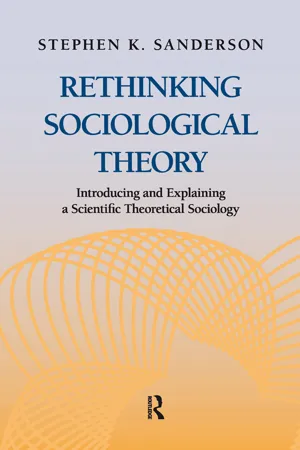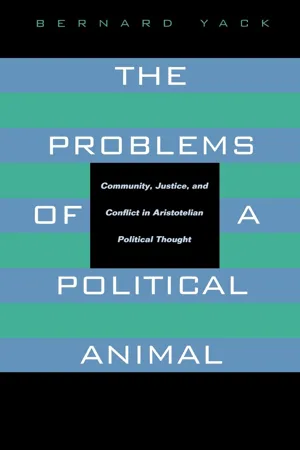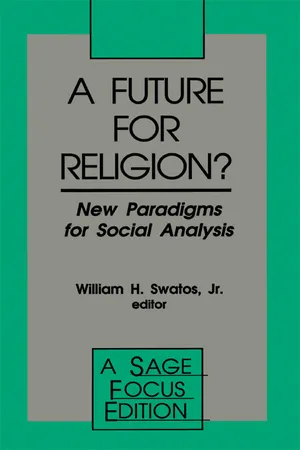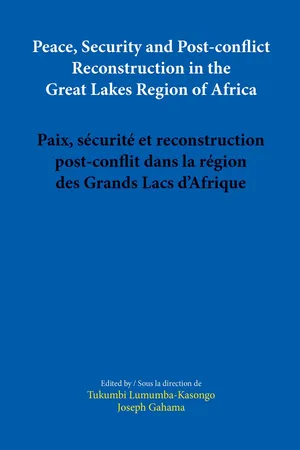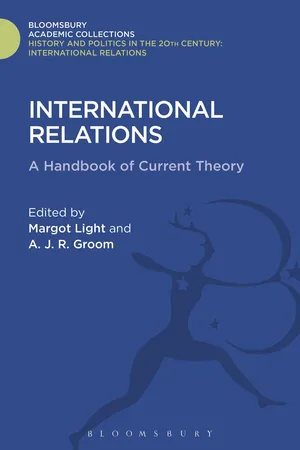Politics & International Relations
Class Conflict
Class conflict refers to the tension and antagonism between different social classes, particularly between the working class and the capitalist or ruling class. This concept is rooted in the Marxist theory of society, which posits that the struggle for control over resources and power is a fundamental aspect of social dynamics. Class conflict often shapes political and economic systems, influencing policies and societal structures.
Written by Perlego with AI-assistance
Related key terms
1 of 5
6 Key excerpts on "Class Conflict"
- eBook - ePub
Rethinking Sociological Theory
Introducing and Explaining a Scientific Theoretical Sociology
- Stephen K. Sanderson(Author)
- 2015(Publication Date)
- Routledge(Publisher)
2 I have tried to formalize conflict theory by summarizing it in terms of the following set of propositions:1. The essence of social life is people competing for resources, which are often scarce.2. Economic resources and social power are the most important, but not the only, resources that people seek.3. Individuals and groups frequently come into conflict over the distribution of resources.4. This conflict commonly leads to the formation of dominant and subordinate groups.5. Conflict is both intrasocietal and intersocietal.6. On the intrasocietal level, dominant groups tend to gain priority over subordinate groups in influencing the structure of society so as to favor their interests.7. On the intersocietal level, societies seek to realize their interests through controlling, and often dominating, other societies.It is important to be clear about the meaning of the term conflict . It is often assumed that it always involves some sort of overt hostility, such as war, revolution, race riots, and the like. These are indeed important forms of conflict, but conflict theorists use the term much more broadly. The essential meaning of conflict here is opposition of interests . Individuals and groups are engaged in conflict whenever they are struggling for ends so that the gains of one party create losses for another party (or parties). For example, in Marxian conflict theory, the capitalist class seeks profit, which it can only earn by the exploitation of the working class. It is also important to recognize that conflict theory does not focus simply on conflict. It is interested in explaining all aspects of social life, harmony as well as conflict, cooperation as well as competition. In conflict theory, conflict as a result of clashing interests is the explanans, and its explananda are wide ranging and diverse. I make this simple point because some sociologists have taken works like Lewis Coser’s The Functions of Social Conflict 3 - eBook - PDF
The Problems of a Political Animal
Community, Justice, and Conflict in Aristotelian Political Thought
- Bernard Yack(Author)
- 2023(Publication Date)
- University of California Press(Publisher)
21. See the similar conclusion in J. Elster, "Three Challenges to Class," 161. Class Conflict and the Mixed Regime 215 and the most important forms of social conflict. Marx's "optimistic" assumption about the necessary connection between forms of exploita- tion and society-transforming conflict is refuted by the social structure and experience of the ancient Greek republics. Extensive social exploi- tation and intensive Class Conflict clearly existed in these communities; but the latter did not develop directly from the most important ex- amples of the former. Uncomfortable as it may be to admit, classical antiquity's massive forms of slave exploitation developed and passed from the scene without inspiring the kind of social conflict that might wreak vengeance on the exploiters and bring some improvement to the lives of the exploited. To make sense of Class Conflict as it emerges in the ancient Greek republics, we thus need a theoretical approach that does not derive Class Conflict from a general, society-wide account of exploitation. More- over, we need an approach that directly associates Class Conflict and participation in political life. We can find such an approach, I argue, in Aristotle's account of political conflict. A POLITICAL UNDERSTANDING OF Class Conflict For Aristotle, as for most students of classical Greece, 22 the most per- sistent and dangerous source of conflict within political communities is the mutual suspicion between rich and poor citizens. The continuing struggle between oligarchs and democrats, a struggle that occupies the largest part of his account of ordinary political life, is for him primarily a struggle between rich and poor citizens. As Aristotle repeatedly notes, the rule of the few and of the many is better and more precisely under- stood as the rule of the few rich and the many poor (Pol. 1279b, 1290bl). Given this understanding of political conflict, it is quite reasonable to attribute to Aristotle a theory of Class Conflict. - eBook - PDF
A Future for Religion?
New Paradigms for Social Analysis
- William H. Swatos, Jr., William H. Swatos(Authors)
- 1992(Publication Date)
- SAGE Publications, Inc(Publisher)
38 Religion, Class Conflict, Social Justice those who do not adhere to its creed. In this chapter I will examine how religion contributes to social conflict. I will concentrate on how reli-gion, by justifying and legitimating class ideology, sanctifies views of one class that stand in diametric opposition to the views of members of other classes. Conflict Conflict is the hostile condition that results when the interests of one unit in the social system stand in opposition to or are threatened by another unit. Coser’s definition is somewhat more specific. He defines conflict as “a struggle over values and claims to scarce status, power and resources in which the aims of the opponents are to neutralize, in-jure or eliminate their rivals” (1956, 8). Generally, one can say that con-flict and its associated hostility are the result of self and class interests associated with competition for scarce resources. Interests reflect a person’s perception of those conditions that ensure personal or class benefits (or both). In this chapter I will concentrate on the belief systems that provide religious justifications for class interests and thus enhance and support Class Conflict. I am not suggesting that class interests are the only form of conflict in religion. Of course, there are conflicts between various religions associated with matters of faith. These too, however, are part of a power struggle, namely a struggle between various religions who seek to control the definition of truth. Theologians who create and in-terpret religious belief systems also become a part of the intelligentsia, that is, a collectivity of persons who clarify or create ideologies by which classes and individuals justify their worldviews and the legiti-macy or nonlegitimacy of the political system. The difference between the secular and the sacred intelligentsia, that is, between nonreligious and religious ideologists, is that the latter unite other-worldly and this-worldly ends. - eBook - PDF
- Tukumbi Lumumba-Kasongo(Author)
- 2017(Publication Date)
- Codesria(Publisher)
Lumumba-Kasongo: Contemporary Theories of Conflict 35 The conflict is inherent to the nature of the state. As developed throughout nineteenth and twentieth centuries, classical realism was characterised by the theory of balance of power, unilateral militarism, and a sharp distinction between domestic politics and international relations. Additionally, neo-realism, which developed after World War II, places an emphasis on alliance and deterrence. For neo-realists, therefore, the political clout of nations correlates closely with their economic power and their military might. The only source of power is capabilities (Kenneth Waltz 1979:153). Balance of power serves as deterrence against war. But it could also create or intensify tensions among nations. By and large, conflicts are likely to emerge when there are: 1. Lack of trust among nation-states; 2. Imbalance of power among nations or a powerful nation has lost resources and the capacity to maintain the balance of power; it could be that one power is increasing in power much faster than other powers in the same region or sub-region; 3. Over-balancing and under-balancing of power; 4. Lack of sufficient communication among nations; 5. Poorly defined national interests; and 6. The rise of modernisation or the shifting of power through its instruments. Thus, international relations, as perceived and defined within the prism of the neo-classical realism, is all about conflict management. Classical Liberalism The father of liberalism in West, Jean-Jacques Rousseau, has defined it as a unified principle of liberty and equality. These two expressions have been interpreted differently in both economics and political thought depending on the political context and school of thought of interpreters and users. However, in contemporary world, there is no one single theory of classical liberalism. - eBook - ePub
Terms of Trade and Class Relations
An Essay in Political Economy
- Ashok Mitra(Author)
- 2005(Publication Date)
- Routledge(Publisher)
CHAPTER 2 Class Conflict and Classical Political Economy IAs far as classical political economy is concerned, the conflict of class interests was a basic condition of economic life. Adam Smith, in the Introduction and Plan of Work of the Wealth of Nations, promises to enquire not only into the ‘causes’ of the ‘improvement’ in ‘the productive powers of labour’, but also into ‘the order, according to which its produce is naturally distributed among the different ranks and conditions of men in the society’. The moment one talks of ‘ranks and conditions of men’, one is, in fact, talking of classes. Consider also the following passage:As soon as the land of any country has all become private property, the landlords, like all other men, love to reap where they never sowed and demand a rent even for its natural produce…He [the labourer] must then pay for the licence to gather them; and must give up to the landlord a portion of what his labour either collects or produces.1Is there the least doubt that landlords here represent a class, as labour does too, and that a relation of contradiction exists between the two? Later, in the chapter ‘Of the Wages of Labour’, Adam Smith reiterates, explicitly, the theme of class contradiction while discussing the formation of wages in the manufacturing sector:What are the common wages of labour, depends everywhere upon the contract usually made between those two parties [that is, masters and workmen], whose interests are by no means the same. The workmen desire to get as much, the master to give as little as possible. The former are disposed to combine in order to raise, the latter in order to lower the wages of labour.It is not, however, difficult to foresee which of the two parties must, upon all ordinary occasions, have the advantage in the dispute, and force the other into a compliance with their terms. The masters, being fewer in number, can combine much more easily; and the law, besides, authorises, or at least does not prohibit their combinations, while it prohibits those of the workmen. We have no acts of parliament against combining to raise it. In all such disputes the masters can hold out much longer. A landlord, a farmer, a master manufacturer, or merchant though they did not employ a single workman, could generally live a year or two upon the stocks which they have already acquired. Many workmen could not subsist a week, few would subsist a month, and scarce any a year without employment. In the long-run the workman may be as necessary to his master as his master is to him, but the necessity is not so immediate. - eBook - PDF
International Relations
A Handbook of Current Theory
- Margot Light, A.J.R. Groom(Authors)
- 2016(Publication Date)
- Bloomsbury Academic(Publisher)
Sociological and political explanations of the origins of human conflict emphasize social structure and the maldistribution of resources (material and symbolic) as the source of much conflict between human groups and collectivities. Neo-Marxist analysis continues to be based upon the assumption of'objective' conflicts of interest between haves and have-nots within society. This idea is interestingly extended by Dahrendorf s work [34] on a Class Conflict based upon possession of rights to manage and command; by Hechter s ideas on internal colonialism [63], and by the whole school of writing on international stratification, global systems analysis and underdevelopment led by Galtung, Wallerstein [54,141], Chase-Dunn [29] and many others. A number of writers have attempted to synthesize ideas about the origins of discontent, protest and social conflict into a multi-level framework to explain the origin and development of collective social conflict Best known of such attempts is that by Gurr, who has taken the conception of a widespread sense of relative deprivation as the engine for growing discontent, and tried to show how this can 124 CR Mitchell become generalized and mobilized under the right combination of social, economic and political circumstances [58, 59, 60]. Even though operationalizing 'relative deprivation , has proved to be a tricky matter, Gurr's work remains an impressive effort at a general explanation of why and how conflicts arise within a society. Literature on the development of social conflicts and common processes noticeable in particular cases is sparser and less satis-factory than work in most other parts of conflict research. Deutsch [40] has made a number of interesting observations about the nature of benign and malign conflict spirals and factors contributing to each.
Index pages curate the most relevant extracts from our library of academic textbooks. They’ve been created using an in-house natural language model (NLM), each adding context and meaning to key research topics.
